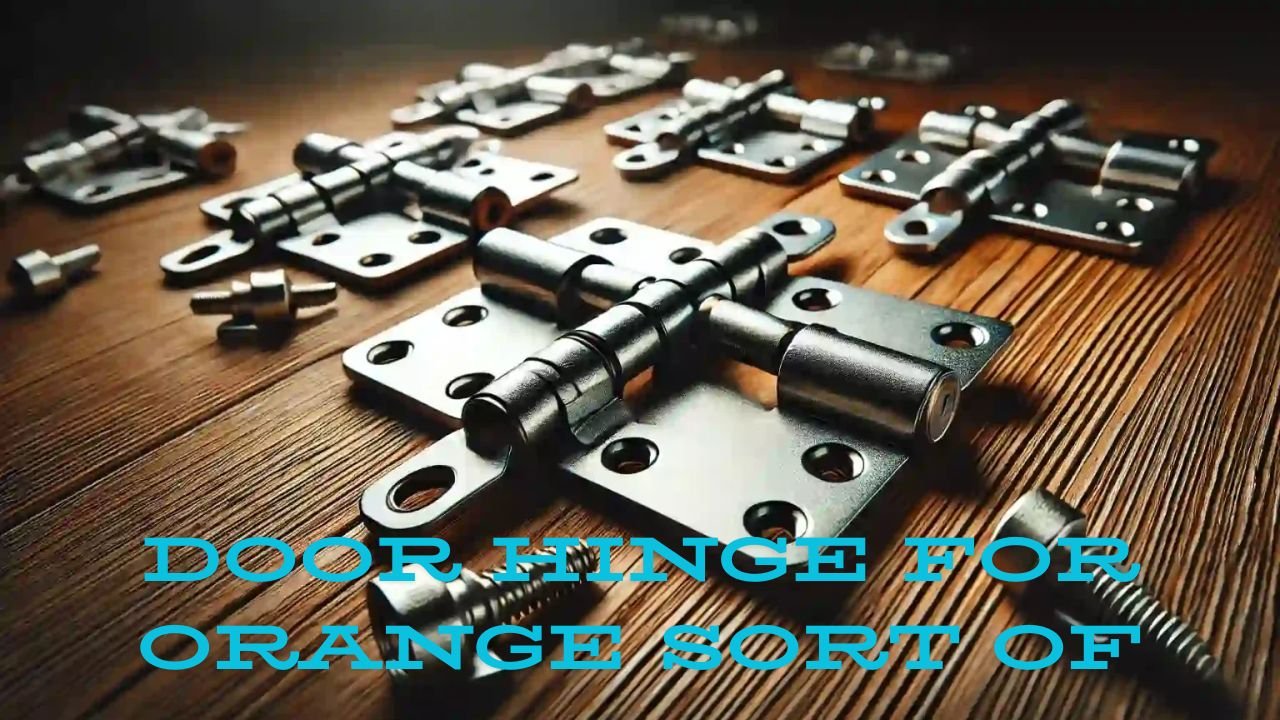The door hinge is one of the most important—yet often neglected—components of a door. Door hinges are essential to the seamless, safe, and secure operation of doors. Despite their apparent simplicity, door hinges come in a wide range of varieties, and their uses can be highly intricate. An extensive overview of door hinges, including information on kinds, materials, installation, maintenance, and more, is intended to be provided by this guide. This post will provide you all the information you require, regardless of whether you work in the construction sector, are a homeowner, or are a do-it-yourself enthusiast.
What is a Door Hinge?
A door hinge is a mechanical bearing that connects a door to its frame, allowing the door to swing open and closed. It typically consists of two plates (also known as leaves) connected by a pin that acts as the pivot point. The plates are attached to the door and the door frame, enabling the door to move smoothly.
Types of Door Hinges
Door hinges come in various types, each designed for specific applications. Choosing the right hinge type is crucial for the door’s functionality, durability, and aesthetics. Here are some common types of door hinges:
Butt Hinges
Butt hinges are the most common type of door hinge and are widely used in residential and commercial buildings. They consist of two rectangular metal plates that are attached to the edge of the door and the door frame. Butt hinges are strong and provide good support, making them ideal for heavy doors.
Key Features:
- Material: Usually made of brass, steel, or stainless steel.
- Applications: Used in interior and exterior doors.
- Advantages: Durable, easy to install, and widely available.
Ball-Bearing Hinges
Ball-bearing hinges are a subtype of butt hinges, equipped with ball bearings between the hinge knuckles. These bearings reduce friction, allowing the door to open and close more smoothly. They are ideal for heavy doors or doors that are frequently used.
Key Features:
- Material: Often made of stainless steel for added strength.
- Applications: Used in heavy doors, such as commercial entry doors.
- Advantages: Smooth operation, long-lasting, and low maintenance.
Pivot Hinges
Pivot hinges are used for doors that need to rotate on a pivot point rather than swinging from the edge. These hinges are typically installed at the top and bottom of the door, allowing the door to rotate on a vertical axis. They are commonly found in commercial settings, such as storefronts or office buildings.
Key Features:
- Material: Typically made from durable metals like stainless steel.
- Applications: Used in heavy, large doors, such as glass doors in commercial spaces.
- Advantages: Supports heavy doors, allows for unique door designs.
Continuous (Piano) Hinges
Continuous hinges, also known as piano hinges, run the entire length of the door. They provide uniform support along the door’s height, making them ideal for applications where extra stability is needed. These hinges are commonly used on piano lids, hence the name.
Key Features:
- Material: Commonly made of stainless steel or brass.
- Applications: Used in doors that require even weight distribution, like cabinets or storage containers.
- Advantages: Provides strong support, reduces the risk of door warping, long-lasting.
Concealed Hinges
Concealed hinges are designed to be hidden when the door is closed, offering a clean and modern look. These hinges are often used in cabinetry and furniture where aesthetics are a priority. They are adjustable and provide a soft-close mechanism, preventing doors from slamming.
Key Features:
- Material: Typically made of steel or zinc alloys.
- Applications: Used in cabinets, wardrobes, and modern furniture.
- Advantages: Aesthetically pleasing, adjustable, provides a soft close.
Overlay Hinges
Overlay hinges are commonly used in cabinetry and allow the door to “overlay” the frame when closed. These hinges are visible when the door is open but concealed when closed, giving a sleek appearance to the cabinetry.
Key Features:
- Material: Often made of steel with a variety of finishes.
- Applications: Used in kitchen cabinets, bathroom vanities, and other furniture.
- Advantages: Easy to install, provides a clean look, adjustable.
Materials Used in Door Hinges
The material of the hinge plays a crucial role in its durability, strength, and appearance. Here are some common materials used in door hinges:
Stainless Steel
Stainless steel is one of the most popular materials for door hinges due to its strength, durability, and resistance to rust and corrosion. It is ideal for both interior and exterior doors, especially in areas with high humidity or exposure to the elements.
Advantages:
- Durability: Long-lasting and resistant to wear and tear.
- Corrosion Resistance: Perfect for exterior use.
- Aesthetics: Offers a sleek, modern look.
Brass
Brass is another common material for door hinges, known for its attractive appearance and resistance to corrosion. It is often used in decorative applications or where the hinge needs to match other brass fittings in the room.
Advantages:
- Aesthetics: Offers a classic, elegant look.
- Corrosion Resistance: Suitable for indoor use.
- Versatility: Available in various finishes like polished, antique, or satin.
Bronze
Bronze is similar to brass but has a slightly darker color, giving it a more rustic or antique appearance. It is often used in traditional or period-style homes where aesthetics are important.
Advantages:
- Aesthetic Appeal: Provides a warm, classic look.
- Durability: Resistant to wear and corrosion.
- Versatility: Can be used in both interior and exterior applications.
Iron
Iron hinges are strong and durable but prone to rust, making them less common in modern applications. They are often used in restoration projects or in homes with a rustic or industrial design.
Advantages:
- Strength: Extremely durable and can support heavy doors.
- Aesthetic Appeal: Ideal for rustic or industrial designs.
- Versatility: Can be finished with paint or other coatings to prevent rust.
Zinc Alloy
Zinc alloy is a cost-effective material often used in budget-friendly hinges. It is lightweight and can be finished to resemble more expensive materials like brass or stainless steel.
Advantages:
- Affordability: Cost-effective for budget projects.
- Versatility: Can be finished in various styles.
- Lightweight: Easy to install and handle.
How to Choose the Right Door Hinge
Choosing the right door hinge involves considering several factors, including the type of door, the weight of the door, the environment, and the aesthetic preferences. Here’s a step-by-step guide to help you select the perfect hinge:
Determine the Door Type
- Interior vs. Exterior: Exterior doors require more robust and weather-resistant hinges, such as stainless steel or bronze.
- Heavy vs. Light Doors: Heavy doors need stronger hinges like ball-bearing or pivot hinges, while lighter doors can use standard butt hinges.
Consider the Environment
- High Humidity: For areas with high humidity or exposure to moisture, choose corrosion-resistant materials like stainless steel or brass.
- Extreme Temperatures: In areas with extreme temperatures, opt for materials that can withstand expansion and contraction, such as bronze or stainless steel.
Think About Aesthetics
- Visible vs. Concealed: Decide whether you want the hinges to be visible or hidden when the door is closed. Concealed hinges provide a sleek look, while visible hinges can add to the door’s design.
- Finish: Choose a finish that complements other hardware in the room, such as door handles, locks, and knobs.
Installation Considerations
- Ease of Installation: Some hinges are easier to install than others. For DIY projects, consider choosing hinges that come with installation instructions or are designed for simple installation.
- Adjustability: If you need to adjust the door after installation, choose adjustable hinges, such as concealed or overlay hinges.
How to Install a Door Hinge
Installing a door hinge may seem daunting, but with the right tools and a step-by-step approach, it can be a straightforward process. Here’s a general guide to installing a door hinge:
Tools You’ll Need:
- Screwdriver or Drill: To attach the hinge to the door and frame.
- Chisel: To create a recess for the hinge in the door and frame.
- Tape Measure: To ensure accurate placement.
- Pencil: To mark the position of the hinges.
- Level: To ensure the door hangs straight.
Step-by-Step Installation Process:
Measure and Mark the Hinge Placement
- Measure the height of the door and divide it into three equal parts. Place the hinges at these marks, typically at the top, middle, and bottom of the door.
- Mark the outline of the hinge on the edge of the door with a pencil.
Create a Recess for the Hinge
- Use a chisel to create a shallow recess (also called a mortise) where the hinge will sit. This ensures the hinge is flush with the edge of the door.
- Do the same on the door frame where the hinge will be attached.
Attach the Hinge to the Door
- Align the hinge with the recess and attach it to the door using screws. Start with the center screw to ensure the hinge stays in place, then add the remaining screws.
- Repeat this process for all hinges.
Attach the Door to the Frame
- Once all the hinges are attached to the door, align the door with the frame.
- Secure the hinges to the door frame using screws, starting with the top hinge and working your way down.
Test the Door
- Open and close the door to ensure it swings smoothly and aligns with the frame.
- Adjust the hinges if necessary to achieve a perfect fit.
How to Maintain Door Hinges
Proper maintenance of door hinges can extend their lifespan and ensure smooth operation. Here are some tips for keeping your door hinges in top condition:
Regular Cleaning
- Wipe down the hinges with a damp cloth to remove dust and dirt. For stubborn grime, use a mild soap solution.
- Avoid using harsh chemicals or abrasive cleaners, as they can damage the hinge’s finish.
Lubrication
- Lubricate the hinges regularly to prevent squeaking and ensure smooth operation. Use a light oil or silicone spray specifically designed for hinges.
- Apply the lubricant to the hinge pin and the knuckles, then open and close the door several times to distribute the oil evenly.
Tighten Loose Screws
- Over time, screws can loosen, causing the door to sag or not close properly. Check the screws periodically and tighten them as needed.
- If a screw hole has become too large, use a wooden dowel or toothpick to fill the hole, then reinsert the screw.
Replace Worn or Damaged Hinges
- If a hinge becomes worn or damaged, it’s important to replace it promptly to avoid further damage to the door or frame.
- Choose a replacement hinge that matches the size, type, and material of the existing hinge.
Common Issues with Door Hinges and How to Fix Them
Door hinges, like any mechanical part, can develop issues over time. Here are some common problems and how to address them:
Squeaky Hinges
- Cause: Lack of lubrication or dirt buildup in the hinge.
- Solution: Clean the hinge thoroughly and apply a lubricant. Open and close the door several times to work the lubricant into the hinge.
Loose Hinges
- Cause: Screws have become loose over time.
- Solution: Tighten the screws or replace them with longer screws for a more secure fit. If the screw holes are stripped, fill them with wood filler or a dowel before reattaching the hinge.
Door Sagging
- Cause: Hinges are loose, or the door is too heavy for the hinges.
- Solution: Tighten the hinges and ensure they are the correct type for the door’s weight. If the hinges are too small or weak, replace them with stronger ones.
Stiff Hinges
- Cause: Dirt or rust buildup, or lack of lubrication.
- Solution: Clean the hinge with a mild cleaner and lubricate it. If the hinge is rusted, you may need to replace it.
Aesthetic Considerations: Making Door Hinges a Design Feature
While door hinges are primarily functional, they can also be a design element that enhances the overall look of your home. Here are some ways to incorporate door hinges into your design:
Choose the Right Finish
- Door hinges come in a variety of finishes, including polished brass, antique bronze, satin nickel, and black. Choose a finish that complements the other hardware in the room, such as door handles and light fixtures.
Decorative Hinges
- If you want to make a statement, consider using decorative hinges that feature intricate designs or patterns. These hinges can add a touch of elegance or character to your doors.
Matching the Style
- The style of the hinge should match the style of the door and the room. For example, ornate brass hinges might be perfect for a traditional or Victorian-style home, while sleek stainless steel hinges are ideal for modern or minimalist designs.
Concealed Hinges for a Sleek Look
- If you prefer a clean, minimalist look, consider using concealed hinges that are hidden when the door is closed. These hinges create a seamless appearance, perfect for modern interiors.
You May Also Like: Homeowner’s Checklist: Preparing for a Roof and Siding Repair Project
Conclusion
Though they might not seem like much, door hinges are crucial to the security, usability, and beauty of your doors. Your doors will function better and last longer if you know about the many kinds of hinges, materials, installation techniques, and maintenance advice. With the knowledge in this extensive tutorial, you will be able to successfully install new doors, replace old hinges, or just maintain your current ones. Recall that choosing the correct hinge can ensure that your doors function properly and continue to look fantastic for many years to come.
FAQs
What are the different types of door hinges, and how do I choose the right one?
There are several types of door hinges, each designed for specific applications. The most common types include:
- Butt Hinges: Used in most interior and exterior doors. They’re strong and easy to install.
- Ball-Bearing Hinges: Ideal for heavy or frequently used doors, providing smooth operation and durability.
- Pivot Hinges: Suitable for heavy or oversized doors, allowing them to rotate on a pivot point.
- Continuous (Piano) Hinges: Run the entire length of the door, offering even weight distribution and support.
- Concealed Hinges: Hidden when the door is closed, providing a clean, modern look.
When choosing a hinge, consider the door type, weight, environment, and desired aesthetic. For heavy doors, opt for ball-bearing or pivot hinges. For a sleek look, choose concealed hinges.
What material is best for door hinges in high-humidity areas?
For high-humidity areas, stainless steel and brass are the best materials for door hinges. Both are highly resistant to rust and corrosion, making them ideal for bathrooms, kitchens, or exterior doors exposed to the elements. Stainless steel offers durability and strength, while brass provides an attractive, classic appearance.
How do I stop my door hinges from squeaking?
To stop door hinges from squeaking, follow these steps:
- Clean the Hinges: Wipe down the hinges with a damp cloth to remove dust and dirt.
- Lubricate the Hinges: Apply a light oil or silicone spray specifically designed for hinges to the hinge pin and knuckles.
- Work the Lubricant In: Open and close the door several times to distribute the lubricant evenly.
Regular lubrication can prevent squeaking and ensure smooth operation.
How do I install door hinges properly?
To install door hinges properly, you’ll need a screwdriver, chisel, tape measure, pencil, and level. Follow these steps:
- Mark Hinge Placement: Measure and mark the door edge where the hinges will be installed.
- Create a Recess: Use a chisel to carve a shallow recess in the door and frame for the hinge to sit flush.
- Attach the Hinge: Align the hinge in the recess and secure it to the door with screws.
- Attach to the Frame: Align the door with the frame and attach the hinges to the frame using screws.
- Test the Door: Open and close the door to ensure it swings smoothly.
Proper installation ensures that the door hangs straight and operates correctly.
What are the signs that a door hinge needs to be replaced?
Signs that a door hinge needs replacement include:
- Squeaking or Stiff Operation: Even after lubrication, if the hinge still squeaks or is stiff, it may be worn out.
- Loose Hinges: If screws are consistently loosening or the door is sagging, the hinge may be failing.
- Visible Damage or Rust: If the hinge is visibly damaged, rusted, or corroded, it should be replaced to prevent further issues.
- Difficulty Closing the Door: If the door doesn’t close properly or drags on the floor, the hinge may be misaligned or worn out.











